‘Mystery Cloud’ Appears Over Eastern U.S. And Canada
Anyone who lives in the eastern part of the United States or Canada and gazing skyward on Tuesday evening may have noticed something strange in their west-northwest sky.
At around 9 p.m. EDT, a small, bright, silvery circular cloud of light suddenly appeared. Over the next 25 minutes, the cloud appeared to gradually expand and fade, finally becoming invisible to the unaided eye. Those who saw it, wondered exactly what it might have been.
John Bortle, a well-known amateur astronomer with over four-decades of experience of sky observing first caught sight of the cloud at 9:03 p.m. EDT from his home in Stormville, New York. Initially, he thought the cloud was as bright as zero or first magnitude and upon examining it carefully with binoculars, thought that it " ... resembled the petals of a day lily." By 9:30 p.m., he reported that the cloud had faded completely from his view.
From the North Fork of Long Island, Bill Bogardus and his wife were out observing when they took note of the cloud " ... about the size of the moon" in the northwest sky. "It was a roundish, yet not all that round, object drifting towards our location very slowly, slower that most satellites because it took at least twenty minutes to move from where we first saw it to pretty much our zenith."
After studying it for a while through an 8-inch telescope, Bogardus noticed two points of light, " ... like a satellite would appear, in line and above a jet of gas that seemed to come from them."
Observing from Ithaca, New York, Joseph Storch used 7x50 binoculars on the cloud and reported a star-like point or nucleus and four butterfly shaped petals radiating outward.
Other reports, received as far west as Toronto tell of people who initially thought that what they were seeing was the moon behind a cloud. Typical was the comment: "For a second I thought it was the moon, then I realized the moon was in the east."
Breaking space news, the latest updates on rocket launches, skywatching events and more!
What was it?
Not a few people who saw this strange, expanding cloud thought that it might have been an atmospheric experiment sent aloft by a sounding rocket. Over the years, those living along the US East Coast have been accustomed to occasionally seeing unusual brightly colored clouds caused when exotic chemicals such as barium and trimethylaluminum were released into the Earth's ionosphere by rockets launched from NASA's Wallops Island, Virginia site.
However, in this case it was the U.S. National Reconnaissance Office -- not NASA -- that was responsible for the unusual cloud formation on Tuesday night.
It was a fuel dump of the Centaur stage involved in the NRO-1 satellite launch from Cape Canaveral late Tuesday afternoon. Dumping excess fuel is the usual practice for all Centaur-booster assisted launches. It happens after spacecraft separation; the fuel bleeding off from a Centaur upper rocket stage on its second orbit after launch. Being just after nightfall, the cloud of fuel was still sunlit at that altitude.
And those who were fortuitously outside when the dump occurred, were the ones who saw this very unusual sight!

Joe Rao is Space.com's skywatching columnist, as well as a veteran meteorologist and eclipse chaser who also serves as an instructor and guest lecturer at New York's Hayden Planetarium. He writes about astronomy for Natural History magazine, Sky & Telescope and other publications. Joe is an 8-time Emmy-nominated meteorologist who served the Putnam Valley region of New York for over 21 years. You can find him on Twitter and YouTube tracking lunar and solar eclipses, meteor showers and more. To find out Joe's latest project, visit him on Twitter.
